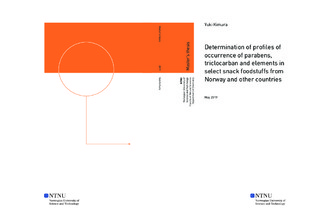| dc.description.abstract | Processed food stuffs are added chemicals to keep stable quality for long periods. While the additives give positive effect to ordinary life, some of these also possibly cause estrogenic problem for our health. Therefore, determination of the quantity of those chemicals in the food stuffs is a very important task. Among food stuffs, snacks are popular in all generations all over the world, however it has not studied yet. Focusing on the snack food stuffs, thus, would provide useful result for choosing it for especially infants who should be cared for health. Comparing the trend by countries and by food types should be emphasis.
In this study, a liquid chromatography tandem mass spectrometry method was developed and employed for the simultaneous determination of six parabens, five parabens derivatives and an antimicrobial in the snack food stuffs. The target parabens were methyl paraben, ethyl paraben, propyl paraben. butyl paraben, benzyl paraben and heptyl paraben, target parabens derivatives were 4-hydroxybenzoic acid, 3,4-dihydroxybenzoic acid, 4-hydroxy-3- methoxybenzoic acid and ethyl-protocatechuic acid, and target antimicrobial was triclocarban. Methyl paraben and ethyl paraben are well known preservatives, while derivatives are previously suggested transformation process from parabens within an organism. In addition, 62 elements were measured in the snack food samples by ICP-MS analysis in order to account for inorganic pollution sources.
The snack food samples analyzed in this study were collected at the markets in seven countries. Solid-liquid extraction was employed for clean-up and extraction process. For concentration, parabens derivatives were basically much higher than parabens, whereas antimicrobial, triclocarban, was presented very low value over all samples. Methyl paraben and ethyl paraben were the most popular preservatives used, but heptyl paraben was only found in low concentrations. No clear between country patterns were found possibly due to international trade. For categorized characteristics, clear difference was found. Further, in the inorganic analysis, accuracy was ±20 % as certified reference materials and parallel/repeating test. Macromineral elements were presented the highest concentration, then trace elements followed. The result also indicated the snacks contained different ingredients depending on the country.
In the PCA analysis, results were separated by characteristics, form, taste and target age. Na and EtP/OH-EtP were positively correlated, which can be a marker to know how amount of EtP would be contained as seeing the product package. | |
